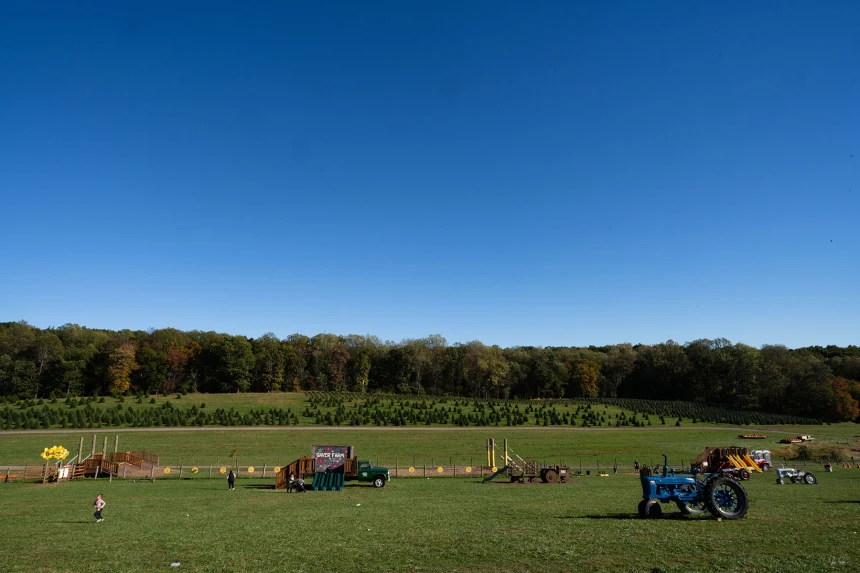
Mt. Airy, Md. — Standing amid rows of Douglas firs and blue spruces, seventh-generation farmer Lisa Gaver can trace the imaginary path of a looming threat. A 500-kilovolt transmission line may soon slice through her 150-acre farm — cutting across parking lots, woods, and a field worth $4 million in Christmas trees.
“It’s going to financially devastate us,” Gaver said, her voice tight with frustration. “This isn’t just a farm — it’s our life’s work.”
For Gaver and dozens of Maryland landowners, the proposed Maryland Piedmont Reliability Project represents more than a power line — it’s a battle for the future of rural America. The $424 million project, led by Public Service Enterprise Group (PSEG) and overseen by PJM Interconnection, would stretch 67 miles through Baltimore, Frederick, and Carroll counties. The goal: meet surging electricity demands fueled by the explosive growth of data centers and artificial intelligence infrastructure.
A Line That Divides Communities
What PSEG calls an essential upgrade, farmers call an “extension cord” for tech giants in Northern Virginia’s “Data Center Alley”, just 50 miles away. That cluster of 200-plus data centers — serving companies like Amazon, Meta, and Microsoft — consumes massive amounts of power, straining the regional grid.
But Maryland’s farmers say they are being asked to shoulder the cost. Hand-painted signs reading “No Eminent Domain for Corporate Gain” now line rural highways. Heated public meetings and social media fights have turned neighbors into opponents, and a growing number of farmers have taken the battle to court.
“People are scared,” said Steve McKay, a Frederick County councilman. “It brings people to tears — the idea that an out-of-state company could use eminent domain to take their land.”
Powering Progress or Displacing Heritage?
According to PSEG, the transmission line is vital. Maryland imports about 40% of its electricity, and PJM warns that without upgrades, the state could face brownouts by 2027. The company insists it will “work proactively to limit any impacts,” claiming that agriculture and agritourism can coexist with power infrastructure.
But opponents argue the costs are too high.
“Once farmland is gone, it’s gone forever,” said Renée Wilson, a fourth-generation farmer who runs a livestock and education center in Parkton. “I’m going to fight this tooth and nail as long as I can.”
Wilson’s property sits in the line’s potential path, and she has been sued by PSEG for refusing to grant access to surveyors.
In court filings, the company even requested U.S. Marshals protection for survey crews, claiming some workers had been threatened by farmers — allegations that residents strongly deny. A federal judge rejected the request, saying the situation did not warrant federal intervention.
A National Pattern of Resistance

The Maryland fight is part of a broader national backlash. Across Kentucky, Missouri, Georgia, and Michigan, communities have protested the spread of data centers — citing their enormous appetite for power and water, minimal job creation, and generous tax breaks. Several counties have imposed temporary moratoriums on new data center construction.
Experts say these conflicts highlight a critical question for America’s tech-driven economy: how to balance digital growth with environmental and agricultural preservation.
“Data centers have become the new factories of the digital age,” said an energy policy analyst. “But unlike factories, they don’t necessarily benefit the towns that host them.”
Lives and Dreams on Hold
For now, Maryland’s farmers live in limbo. The state’s Public Service Commission won’t decide on the project until 2027, leaving years of uncertainty.
In Carroll County, Melvin Baile fears that the proposed lines — which may hover over his leased cornfields — could disrupt the drones and crop-spraying helicopters that protect his harvests.
“We’re fighting the unknown,” Baile said. “It’s scary when you don’t know if you can keep farming the same way.”
The uncertainty has already stalled dreams. In Baltimore County, Brandon and Marie Hill hoped to create a 60-acre “food forest” of walnuts, berries, and chestnuts. Now, they’ve paused planting until they know whether transmission towers will slice through their land.
“That was our American dream,” Hill said. “And now it’s hanging by a wire — literally.”
Political Pressure and Public Outcry
Local officials have urged Governor Wes Moore and even President Donald Trump to intervene. Moore has expressed “grave concerns” but stopped short of action. The White House, meanwhile, has blamed Maryland’s energy issues on the closure of coal plants and emphasized the need for more power sources to support the growing AI economy.
Carroll County Commissioner Kenneth Kiler, who helped draft the letter to Trump, said the community deserves transparency. “We may not like the final answer, but we’d at least like to be heard.”
The Human Cost of Modern Power

Back at Gaver’s Farm in Mt. Airy, visitors continue to arrive for apple cider doughnuts and Christmas trees, unaware of the invisible line that could soon cross the property. Gaver tries to stay focused on the holiday season — reminding her daughter to order more “apple sippers” for the gift shop — but her anxiety lingers.
“Would anyone want to pick apples under a transmission tower?” she asked. “Would insurance even cover us if a line runs overhead?”
She looked across the fields she and her husband began planting more than four decades ago.
“It’s hard to say, ‘I built this for 43 years, and someone can just take it away,’” she said quietly. “It feels like we’re losing the American dream — one power line at a time.”


